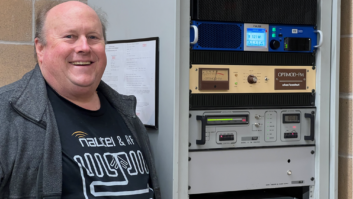I am a 40-plus-year veteran of commercial radio and still work in it; I also volunteer as an adviser to a couple of low-power FM groups and do some volunteer work for their stations.
I appreciate the opinions of Mr. Robert E. Lee (June 17 issue), at least the part of his letter in which he recognized that some LPFMs are trying to serve segments of local communities.

iStockphoto/bakhtiar_zein I could appreciate them more if not for a few facts.
Let’s take for example one new LPFM operator in Ohio.
There are two full-power stations in its town: a daytime, 1 kW commercial AM station, and a Class A 3 kW FM operator on a commercial frequency running today as a noncom repeating the programming of K-Love.
You can’t see the management of either station in town, because there is no traditional “office” for either. (I haven’t been in the FM’s studio building since I took an FCC inspector through it in 1975). The FM is essentially a satellite dish at the tower site.
The AM studio building is not manned. That station’s programming comes from the home office in a city 20 miles or so away. Its programming is geared toward rural communities near and around the medium metro market which its home community sits next to.
Neither station provides even 5 minutes of programming per week to either the local community of which I speak, or the community that contains another commercial daytime AM owned by this broadcaster. It’s all about the original station’s hometown and the nearby metro market.
Local businessmen with whom I have talked are irate about the situation, and have been for years now. One told me not long ago that the only time they see someone from the AM station is when a salesperson comes through hitting them up for advertising on their summer broadcasts from the weeklong county fair.
The county emergency management services must not be too thrilled with that FM or AM station, either. That’s why when the LPFM made a plea, the operators agreed to purchase the EAS equipment for the station. And though LPFMs are not obligated to do this, this station has installed their equipment in such a manner that it will interrupt programming in the event of an emergency.
So, these commercial stations must be owned by a big consolidator, right? Nope. They’re both small owners.
Apparently, the FCC must be aware that there are some commercial operations are being run like this, or they wouldn’t have established LPFM service in the first place. They didn’t establish them to be overblown Part 15s. They didn’t establish them to be toys. They were established to serve public interest, convenience and necessity — something that some, though certainly not all, commercial operators have forgotten or deliberately ignore.
Now LPFMs are asking for some help from the commission on a number of things in two proposals from two separate groups, REC Networks and the LPFM AG group. Each of the two has at least some valid points in their proposals, whether either side can get all it wants or not.
PROPOSAL ONE
First, power increase.
The original LPFM proposal was for (as I recall reading in the pages of this magazine) 1,000 W and commercial operation. This was killed by lobbying from big broadcasters and the NAB. LPFMs were limited to 100 W ERP at 100 feet HAAT.
Let’s do some engineering here. This power and tower height, with favorable terrain on a good propagation day, will get your signal 3 to 5 miles on a car radio. Inside a building, you’re lucky to get more than a mile or so on a typical table radio without an antenna installed. With extremely favorable terrain, you “might” get a little more distance in-car (just like my 10 W high school station could be heard on hilltops in car eight miles away).
A 3 kW commercial Class A can reach (according to the textbook for the college radio classes I teach) 15 to 20 miles, assuming favorable terrain and lack of interference from co-channel spacing issues. And the penetration is generally good for a distance of some miles from the transmitter.
The engineering adage is: Double the power and half the distance. The current proposal of 250 watts would extend the signal range in- car up to about another 2.5 miles and would allow for better building penetration close to the transmitter.
Two hundred and fifty watts is the power level for a translator. But I don’t see a request or suggestion that LPFMs should be allowed the same tower height of translators. (An 80 W translator at 500 feet can cover an entire county.) In fact, 100-foot tower height is still what’s proposed.
Yes, LPFMs would like to be given “primary” service status. Why? Do the math: It costs about $25,000 to get one of these stations through the licensing process and on the air. If you operate frugally, your annual operating budget is around $15,000 to $25,000. (Some stations get deals on studio space and/or electricity, which can help.) That means you have to hope to get a lot of underwriting donations to cover that nut and, hopefully, have a little money left over at the end to put back in the business.
These stations get no help at all from government grants or organizations such as the Corporation for Public Broadcasting. They’re largely on their own, and have to make it on their own.
And yet, as a “secondary” service, if a big broadcaster wants the frequency, they can terminate years and years of hard work, blood, sweat and tears with a phone call. And I’m not talking about one to the FCC. I’m talking about the one that says, “We want your frequency for a translator. Nice to know you. Goodbye.” Why would a business sign an underwriting donation agreement for a year knowing this? The challenge for many LPFMs at first is explain to businesses what underwriting is … and to make them understand the language restrictions that go into underwriting. This alone scares many potential underwriters off.
Commercials on LPFM? It was originally the suggestion. And I wouldn’t object to a potential compromise that would at least allow the stations to run a small number of ads to allow them to barter services. But this may, in the end, be a non-starter. The LPFMs I work with are prepared to deal with the situation either way.
PROPOSAL TWO
What we — the three LPFMs with which I am associated, WRPO/WOHP in Russells Point and Huntsville, Ohio, and WALH in Wilmington, Ohio — would like to see is some clarification with the underwriting rules.
Let’s face it. If you only bill $15,000 or so annually, you can’t afford a communications lawyer. “Go read the rules,” we’re told. We do. Yet, it seems like every so often somebody “clarifies” a rule in a way that raises more questions than it answers.
Recently, a station was fined for having too many “items” in an underwriting announcement. Yet the announcement fit the 30-seconds-or-less standard and contained no promotional or comparative language. What makes an announcement with eight items in a 30 or less message illegal, and an announcement with seven legal? No answer there.
Slogans. They’re allowed if the language in them is not promotional and if a business has been using them for six months or more. Okay, define promotional. How about “Subway … eat fresh!” Ask that question and you get 100 different answers. Go to the FCC and all they will say is: “If the business has been using the slogan for six months or longer, it is probably OK.” They won’t go further than that. I know that for a fact based on personal experience.
Are you aware that an LPFM cannot run a PSA that says “The (name) High School Dare Program is holding a car wash this Saturday from 11 a.m. to 3 p.m. to help the family of (student) pay for a funeral marker for him after he died at the hand of a drunk driver”? Not legal. An LPFM cannot promote the activities of another nonprofit. Please tell me who would be hurt allowing this type of message.
At least one of the two proposals petitions the FCC to allow this type of announcement on LPFM stations.
Now I better understand the pain of commercial broadcasters over the indecency laws.
Anything else in either proposal would be icing on the cake to the LPFMs I work with.
FARM TEAM
Bottom line, commercial broadcasters: Most LPFMs that I know have no intention of doing anything other than serve their communities, operate as the nonprofits they are, but hopefully make enough that they can grow their businesses … and maybe, someday, even be able to afford to pay a part time employee or two. Or at least pay a stipend.
But if a commercial broadcaster abdicates its responsibilities to serve the public interest, convenience and necessity such as the case of the community in Ohio, LPFMs are prepared to fill that void. And if one of you guys eventually loses out, if a full-power commercial station is ever actually beaten by a 100- or 250-watt noncom, then if you want to find the villain just go look in a mirror.
One last point: The LPFM in that Ohio community had its license application challenged twice during the licensing process by a Class A commercial operator over 90 miles away in another state claiming its “fringe” coverage would suffer interference from the LPFM. The FCC laughed it out of the docket eventually, but the LPFM had to pay a lawyer twice to represent them.
So who’s really looking for special favors? Or, perhaps the question is, who’s looking for government-granted protection from the most remote of potential competition?
Broadcasters lament the loss of the “farm team” for up-and-coming talent because commercial radio no longer has those entry-level jobs on its budget lines. An LPFM can fulfill its “educational” mission by training potential broadcasters of tomorrow. As some of us look toward our retirement years, a vibrant LPFM service — one that helps commercial broadcasters find talent who can create compelling content —would be a great legacy to broadcasters of my generation. That’s why I got involved with this service.
Comment on this or any story. Email [email protected] with “Letter to the Editor” in the subject field.










